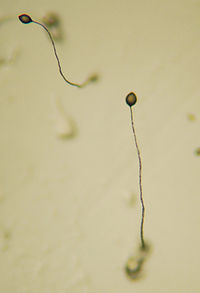
The social amoeba dictyostelium discoideum rescues paraburkholderia hayleyella, but not P. agricolaris, from interspecific competition.
Sign Up to like & getrecommendations! Published in 2023 at "FEMS microbiology ecology"
DOI: 10.1093/femsec/fiad055
Abstract: Bacterial endosymbionts can provide benefits for their eukaryotic hosts, but it is often unclear if endosymbionts benefit from these relationships. The social amoeba Dictyostelium discoideum associates with three species of Paraburkholderia endosymbionts, including P. agricolaris… read more here.
Keywords: amoeba dictyostelium; social amoeba; agricolaris; competition ... See more keywords

Mapping and characterization of G-quadruplexes in the genome of the social amoeba Dictyostelium discoideum
Sign Up to like & getrecommendations! Published in 2019 at "Nucleic Acids Research"
DOI: 10.1093/nar/gkz196
Abstract: Abstract G-quadruplexes (G4) are non-canonical DNA and/or RNA secondary structures formed in guanine-rich regions. Given their over-representation in specific regions in the genome such as promoters and telomeres, they are likely to play important roles… read more here.
Keywords: genome; dictyostelium; dictyostelium discoideum; social amoeba ... See more keywords

Cyclic dominance emerges from the evolution of two inter-linked cooperative behaviours in the social amoeba
Sign Up to like & getrecommendations! Published in 2018 at "Proceedings of the Royal Society B: Biological Sciences"
DOI: 10.1098/rspb.2018.0905
Abstract: Evolution of cooperation has been one of the most important problems in sociobiology, and many researchers have revealed mechanisms that can facilitate the evolution of cooperation. However, most studies deal only with one cooperative behaviour,… read more here.
Keywords: evolution; behaviours social; cyclic dominance; formation ... See more keywords

The specificity of Burkholderia symbionts in the social amoeba farming symbiosis: Prevalence, species, genetic and phenotypic diversity
Sign Up to like & getrecommendations! Published in 2019 at "Molecular Ecology"
DOI: 10.1111/mec.14982
Abstract: The establishment of symbioses between eukaryotic hosts and bacterial symbionts in nature is a dynamic process. The formation of such relationships depends on the life history of both partners. Bacterial symbionts of amoebae may have… read more here.
Keywords: burkholderia; symbiosis; burkholderia symbionts; social amoeba ... See more keywords

Symbiont-Induced Phagosome Changes Rather than Extracellular Discrimination Contribute to the Formation of Social Amoeba Farming Symbiosis
Sign Up to like & getrecommendations! Published in 2022 at "Microbiology Spectrum"
DOI: 10.1128/spectrum.01727-21
Abstract: Protists are single-celled, extremely diverse eukaryotic microbes. Like animals and plants, they live with bacterial symbionts and have complex relationships. ABSTRACT Symbiont recognition is essential in many symbiotic relationships, especially for horizontally transferred symbionts. Therefore,… read more here.
Keywords: extracellular discrimination; symbiont induced; social amoeba; induced phagosome ... See more keywords

Insights on Microsatellite Characteristics, Evolution, and Function From the Social Amoeba Dictyostelium discoideum
Sign Up to like & getrecommendations! Published in 2022 at "Frontiers in Neuroscience"
DOI: 10.3389/fnins.2022.886837
Abstract: Microsatellites are repetitive sequences commonly found in the genomes of higher organisms. These repetitive sequences are prone to expansion or contraction, and when microsatellite expansion occurs in the regulatory or coding regions of genes this… read more here.
Keywords: dictyostelium discoideum; amoeba dictyostelium; dictyostelium; social amoeba ... See more keywords